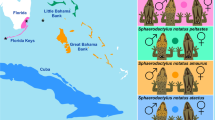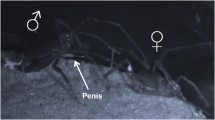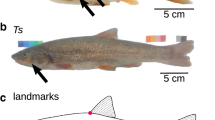Abstract
Cave fishes need to rely on non-visual senses, such as the sense of smell or the lateral line to communicate in darkness. In the present study, we investigated sex identification by females of a cave-dwelling livebearing fish, Poecilia mexicana (cave molly), as well as its surface-dwelling relatives. Unlike many other cave fishes, cave mollies still possess functional eyes. Three different modes of presentation of the stimulus fish (a male and an equally sized female) were used: (i) the stimulus fish were presented behind wire-mesh in light, allowing the focal female to perceive multiple cues, (ii) the experiment was carried out under infrared conditions, such that only non-visual cues could be perceived and (iii) the stimulus fish were presented in light behind transparent Plexiglas, allowing for the use of visual cues only. Females of all populations examined preferred to associate with the stimulus female in at least one of the treatments, but only when visible light was provided, suggesting that far-range sex recognition is limited or even absent in the cave molly under naturally dark conditions.

Similar content being viewed by others
References
Agrillo C, Dadda M, Bisazza A (2006) Sexual harassment influences group choice in female mosquitofish. Ethology 112:592–598
Barr TC, Holsinger JR (1985) Speciation in cave faunas. Ann Rev Ecol Syst 16:313–337
Bisazza A, Marin G (1995) Sexual selection and sexual size dimorphism in the eastern mosquitofish Gambusia holbrooki (Pisces: Poeciliidae). Ethol Ecol Evol 7:169–183
Burt de Perera T (2004a) Spatial parameters encoded in the spatial map of the blind Mexican cave fish, Astyanax fasciatus. Anim Behav 68:291–295
Burt de Perera T (2004b) Fish can encode order in their spatial map. Proc R Soc Lond B 271:2131–2134
Constantz GD (1989) Reproductive biology of poeciliid fishes. In: Meffe G K, Snelson FF (eds ) Ecology and evolution of livebearing fishes (Poeciliidae). Prentice Hall, New Jersey pp 33–50
Crapon de Caprona MD, Ryan MJ (1990) Conspecific mate recognition in swordtails, Xiphophorus nigrensis and X. pygmaeus (Poeciliidae): olfactory and visual cues. Anim Behav 39:290–296
Culver DC (1982) Cave life — evolution and ecology. Harvard University Press, Cambridge
Culver DC, Kane TC, Fong DW (1995) Adaptation and natural selection in caves: The evolution of Gammarus minus. Harvard University Press, Cambridge
Dadda M, Pilastro A, Bisazza A (2005) Male sexual harassment and female schooling behaviour in the eastern mosquitofish. Anim Behav 70:463–471
Fisher HS, Rosenthal GG (2006) Female swordtail fish use chemical cues to select well-fed mates. Anim Behav 72:721–725
Fisher HS, Wong BBM, Rosenthal GG (2006) Alteration of the chemical environment disrupts communication in a freshwater fish. Proc Roy Soc Lond B 273:1187–1193
Godin J-GJ (1995) Predation risk and alternative mating tactics in male Trinidadian guppies (Poecilia reticulata). Oecologia 103:224–229
Gordon MS, Rosen DE (1962) A cavernicolous form of the Poeciliid fish Poecilia sphenops from Tabasco, México. Copeia 1962:360–368
Griffiths SW (1996) Sex differences in the trade-off between feeding and mating in the guppy. J Fish Biol 48:891–898
Griffiths SW (1997) Schooling decisions in guppies (Poecilia reticulata) are based on familiarity rather than kin recognition by phenotype matching. Behav Ecol Sociobiol 45:437–443
Houde AE (1997) Sex, color, and mate choice in guppies. Princeton University Press, Princeton, New Jersey, USA
Istenič L, Bulog B (1984) Some evidence for the ampullary organs in the European cave salamander Proteus anguinus (Urodela, Amphibia). Cell Tissue Res 253:393–402
Jeffery WR (2001) Cavefish as a model system in evolutionary and developmental biology. Develop Biol 231:1–12
Jeffery WR (2005) Adaptive evolution of eye degeneration in the Mexican blind cavefish. J Hered 96:185–196
Körner KE, Schlupp I, Plath M, Loew ER (2006) Spectral sensitivity of mollies: comparing surface- and cave-dwelling Atlantic mollies, Poecilia mexicana. J Fish Biol 69:54–65
Kramer DL, McClure M (1982) Aquatic surface respiration, a widespread adaptation to hypoxia in tropical freshwater fishes. Environ Biol Fish 7:47–55
Langecker TG (2000) The effect of continuous darkness on cave ecology and cavernicolous evolution. In: Wilkens H, Culver DC, Humphries WF Ecosystems of the world 30: Subterranean Ecosystems. Elsevier Science pp 135–157
Langecker TG, Longley G (1993) Morphological adaptations of the Texas blind catfishes Trogloglanis pattersoni and Satan eurystomus (Siluriformes, Ictaluridae) to their underground environment. Copeia 1993:976–986
Liley NR (1966) Ethological isolating mechanisms in four sympatric species of poeciliid fishes. Behaviour 13:1–197
Liley NR (1983) Hormones, pheromones, and reproductive behavior in fishes. In: Hoar WS, Randall DJ (eds) Fish Physiology, Vol 3. Academic Press, New York, pp 73–116
Magurran AE (2001) Sexual conflict and evolution in Trinidadian guppies. Genetica 112/113:463–474
Magurran AE, Seghers BH (1994a) A cost of sexual harassment in the guppy, Poecilia reticulata. Proc R Soc Lond B 258:89–92
Magurran AE, Seghers BH (1994b) Sexual conflict as a consequence of ecology: evidence from guppy, Poecilia reticulata, populations in Trinidad. Proc R Soc Lond B 255:31–36
McLennan DA, Ryan MJ (1997) Responses to conspecific and heterospecific olfactory cues in the swordtail Xiphophorus cortezi. Anim Behav 54:1077–1088
Miller RR (1966) Geographic distribution of Central American freshwater fishes. Copeia 1966:773–802
Miller RR (2005) Freshwater fishes of Mexico. Chicago University Press, Chicago
Montgomery JC, Coombs S, Baker CF (2001) The mechanosensory lateral line system of the hypogean form of Astyanax fasciatus. Environ Biol Fish 62:87–96
Parzefall J (1969) Zur vergleichenden Ethologie verschiedener Mollienesia-Arten einschließlich einer Höhlenform von Mollienesia sphenops. Behaviour 33:1–37
Parzefall J (1970) Morphologische Untersuchungen an einer Höhlenform von Mollienesia sphenops (Pisces, Poeciliidae). Z Morph Tiere 68:323–342
Parzefall J (1973) Attraction and sexual cycle of Poeciliids. In: Schröder J H (ed ) Genetics and mutagenesis of fish. Springer Berlin, Heidelberg, New York, pp 177–183
Parzefall J (1974) Rückbildung aggressiver Verhaltensweisen bei einer Höhlenform von Mollienesia sphenops (Pisces, Poeciliidae). Z Tierpsychol 35:66–84
Parzefall J (1976) Die Rolle der chemischen Information im Verhalten des Grottenolms Proteus anguinus Laur. (Proteidae, Urodela). Z Tierpsychol 42:29–49
Parzefall J (1979) Zur Genetik und biologischen Bedeutung des Aggressionsverhaltens von Poecilia sphenops (Pisces, Poeciliidae). Z Tierpsychol 50:399–422
Parzefall J (1993a) Behavioural ecology of cave-dwelling fishes. In: Pitcher T J (ed ) Behaviour of teleost fishes, second edition. Chapman & Hall, London, pp 573–608
Parzefall J (1993b) Schooling behaviour in population-hybrids of Astyanax fasciatus and Poecilia mexicana (Pisces, Characidae and Poeciliidae). In: Schröder H, Bauer J, Schartl M (eds ) Trends in Ichthyology: an international perspective. Blackwell Scientific, Oxford, pp 297–303
Parzefall J (2001) A review of morphological and behavioural changes in the cave molly, Poecilia mexicana, from Tabasco, Mexico. Environ Biol Fish 62:263–275
Parzefall J, Durand JP, Richard B (1980) Chemical communication in Necturus maculosus and his cave living relative Proteus anguinus (Proteidae, Urodela). Z Tierpsychol 53:133–138
Parzefall J, Behrens J, Döbler M, Reifenstein K (2000) Chemical communication in the Pyrenean salamander Euproctus asper (Caudata, Salamandridae). Mem Biospeol 27:123–129
Peters N, Peters G, Parzefall J, Wilkens H (1973) Über degenerative und konstruktive Merkmale bei einer phylogenetisch jungen Höhlenform von Poecilia sphenops (Pisces, Poeciliidae). Int Rev Ges Hydrobiol 58:417–436
Pilastro A, Benetton S, Bisazza A (2003) Female aggregation and male competition reduce costs of sexual harassment in the mosquitofish Gambusia holbrooki. Anim Behav 65:1161–1167
Plath M, Körner KE, Schlupp I, Parzefall J (2001) Sex recognition and female preferences of cave mollies Poecilia mexicana (Poeciliidae, Teleostei) in light and darkness. Mem Biospeol 28:163–167
Plath M, Parzefall J, Schlupp I (2003a) The role of sexual harassment in cave and surface dwelling populations of the Atlantic molly, Poecilia mexicana (Poeciliidae, Teleostei). Behav Ecol Sociobiol 54:303–309
Plath M, Wiedemann K, Parzefall J, Schlupp I (2003b) Sex recognition in surface and cave dwelling male Atlantic mollies Poecilia mexicana (Poeciliidae, Teleostei). Behaviour 140:765–782
Plath M, Brümmer A, Schlupp I (2004a) Sexual harassment in a livebearing fish (Poecilia mexicana): influence of population-specific male mating behaviour. Acta Ethol 7:65–72
Plath M, Parzefall J, Körner KE, Schlupp I (2004b) Sexual selection in darkness? Female mating preferences in surface and cave dwelling Atlantic mollies, Poecilia mexicana (Poeciliidae, Teleostei). Behav Ecol Sociobiol 55:596–601
Plath M, Heubel KU, Schlupp I (2005a) Field observations on male mating behavior in surface- and cave-dwelling Atlantic mollies (Poecilia mexicana, Poeciliidae) Z Fischk 7(2):113–119
Plath M, Heubel KU, García de León FJ, Schlupp I (2005b) Cave molly females (Poecilia mexicana, Poeciliidae, Teleostei) like well fed males. Behav Ecol Sociobiol 58:144–151
Plath M, Rohde M, Schröder T, Taebel-Hellwig A, Schlupp I (2006a) Female mating preferences in blind cave tetras Astyanax fasciatus (Characidae, Teleostei). Behaviour 143:15–32
Plath M, Seggel U, Burmeister H, Heubel KU, Schlupp I (2006b) Choosy males from the underground: Male mate choice in surface- and cave-dwelling Atlantic mollies, Poecilia mexicana (Poeciliidae, Teleostei). Naturwissenschaften 93:103–109
Plath M, Hauswaldt JS, Moll K, Tobler M, García de León FJ, Schlupp I, Tiedemann R (2007a) Local adaptation and pronounced genetic differentiation in an extremophile fish, Poecilia mexicana, from a Mexican cave with toxic hydrogen sulfide. Mol Ecol 16:967–976
Plath M, Makowicz AM, Schlupp I, Tobler M (2007b) Sexual harassment in live-bearing fishes: comparing courting and non-courting species. Behav Ecol 18:680-688
Plath M, Tobler M, Riesch R, García de León FJ, Giere O, Schlupp I (2007c) Survival in an extreme habitat: the roles of behaviour and energy limitation. Naturwissenschaften (in press) DOI 10.1007/s00114-007-0279-2
Poschadel JR, Rudolph A, Warbeck A, Plath M (2005) Influence of visual and chemical cues on the aggregation behavior of Pyrenean mountain newts, Euproctus asper (Urodela, Salamandridae). Subterran Biol 3:63–68
Poschadel JR, Rudolph A, Plath M (2007) Non-visual mate choice in the Pyrenean mountain newt (Euproctus asper): females prefer small males. Acta Ethol 10:35–40
Riesch R, Schlupp I, Tobler M, Plath M (2006) Reduction of the association preference for conspecifics in surface- and cave-dwelling Atlantic mollies, Poecilia mexicana. Behav Ecol Sociobiol 60:794–802
Romero A, Green SM (2005) The end of regressive evolution: examining and interpreting the evidence from cave fishes. J Fish Biol 67:3–32
Schemmel C (1967) Vergleichende Untersuchungen an den Hautsinnesorganen ober- und unterirdisch lebender Astyanax-Formen. Ein Beitrag zur Evolution der Cavernicolen. Z Morph Tiere 61:255–316
Schlupp I, Parzefall J, Schartl M (1991) Male mate choice in mixed bisexual/unisexual breeding complexes of Poecilia (Teleostei: Poeciliidae). Ethology 88:215–222
Schlupp I, McKnab R, Ryan MJ (2001) Sexual harassment as a cost for molly females: Bigger males cost less. Behaviour 138:277–286
Tobler M, Schlupp I, Heubel KU, Riesch R, García de León FJ, Giere O, Plath M (2006) Life on the edge: Hydrogen sulfide and the fish communities of a Mexican cave and surrounding waters. Extremophiles 10:577–585
Walters LH, Walters VW (1965) Laboratory observations on a cavernicolous poeciliid from Tabasco, Mexico. Copeia 1965:214–233
Weber A (1995) The lateral line system of epigean and cave dwelling catfishes of the genus Rhamdia (Pimelodidae, Teleostei) in Mexico. Mem Biospeol 22:215–225
Weber A (2000) Fish and amphibia. In: Wilkens H, Culver DC, Humphries WF (eds ) Ecosystems of the world 30: Subterranean ecosystems. Elsevier, Amsterdam, pp 109–132
Weber A, Proudlove GS, Parzefall J, Wilkens H, Nalbant TT (1998) Pisces (Teleostei): morphology, systematic diversity, distribution and ecology of stygobitic fishes. In: Juberthie C, Decu V (eds ) Encyclopaedia Biospeologica, Vol 2 Société de Biospéologie, Moulis, Bucarest, pp 1–8
Wenzel M (1997) Einfluß optischer und chemischer Reize auf Partnerwahlentscheidungen im Poecilia formosa Fortpflanzungskomplex (Teleostei, Poeciliidae). Unpublished diploma thesis, University of Hamburg
Wilkens H (1982) Regressive evolution and phylogenetic age: The history of colonization of freshwaters of Yucatan by fish and crustacea. Bull Tex Mem Mus 28:237–243
Wilkens H (1988) Evolution and genetics of epigean and cave Astyanax fasciatus (Characidae, Pisces). Evol Biol 23:271–367
Wyatt TD (2003) Pheromones and animal behaviour, communication by smell and taste. Cambridge University Press, Cambridge
Zeiske E (1968) Prädispositionen bei Mollienesia sphenops (Pisces, Poeciliidae) für einen Übergang zum Leben in subterranen Gewässern. Z vergl Physiol 58:190–222
Zeiske E (1971) Ethologische Mechanismen als Voraussetzung für einen Übergang zum Höhlenleben. Untersuchungen an Kaspar-Hauser-Männchen von Poecilia sphenops (Pisces, Poeciliidae). Forma functio 4/1971:270–282
Acknowledgements
We are grateful to the people of Tapijulapa for their hospitality during our visits. The Mexican Government kindly issued permits to collect fish (Permiso de pesca de fomento numbers: 291002-613-1577 and DGOPA/5864/260704/-2408). Financial support came from the DFG to M. P. (PL 470/1-1), the German Ichthyological Association (to M. T. and M. P. ) as well as the Basler Foundation for Biological Research, the Janggen-Poehn-Foundation, the Roche Research Foundation, and the Wolfermann-Nägeli-Foundation (to M. T. ). We are indebted to J. Parzefall for introducing us to the biology of the cave molly.
Author information
Authors and Affiliations
Corresponding author
Rights and permissions
About this article
Cite this article
Plath, M., Tobler, M. Sex recognition in surface- and cave-dwelling Atlantic molly females (Poecilia mexicana, Poeciliidae, Teleostei): influence of visual and non-visual cues. acta ethol 10, 81–88 (2007). https://doi.org/10.1007/s10211-007-0033-y
Received:
Revised:
Accepted:
Published:
Issue Date:
DOI: https://doi.org/10.1007/s10211-007-0033-y




